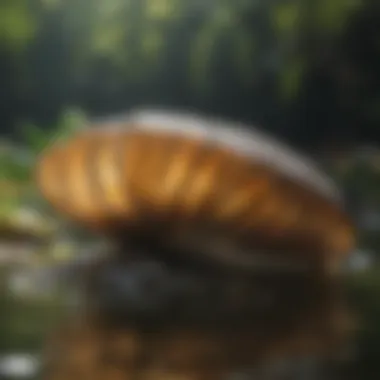Understanding Invasive Species Impact in the US


Intro
Invasive species are organisms that are not native to a specific location and can disrupt ecosystems and local species. In the United States, these species present substantial challenges to biodiversity and natural resource management. This article will examine several examples of invasive species that have made their way into various ecosystems across the country. Understanding these species is critical for forestry professionals, academics, and conservationists who are committed to maintaining ecological balance and promoting sustainable management practices.
Understanding Woodland Ecosystems
Woodland ecosystems are complex systems, and they play a vital role in maintaining ecological health. The diversity of life within these forests contributes significantly to their resilience against invasive species.
Importance of Biodiversity in Forests
Biodiversity serves as a foundational element in forest ecosystems. It fosters interactions among species and allows for various ecological functions such as nutrient cycling and energy flow. A rich biodiversity helps forests withstand disturbances, making them less vulnerable to invasive species that can thrive in less diverse environments. The presence of native species also promotes natural pest control and can limit the proliferation of invasive organisms.
Role of Forests in Climate Regulation
Forests make significant contributions to climate regulation. They sequester carbon dioxide, thereby mitigating climate change impacts. The loss of native species due to invasives can impair this ability, leading to increased carbon emissions. This highlights the need for awareness and proactive measures to address invasives effectively, as their impact reverberates beyond local ecosystems.
Sustainable Forestry Practices
Sustainable forestry practices are essential in combatting invasives and preserving ecological integrity. These practices can minimize degradation and encourage healthy diverse ecosystems.
Principles of Sustainable Forestry
Sustainable forestry is guided by several principles aimed at achieving balance between ecological health and resource extraction:
- Maintaining biodiversity: Ensuring a variety of species is present.
- Protecting water quality: Managing water resources to prevent pollution.
- Promoting regeneration: Allowing forests to naturally regenerate after removal of trees.
Understanding these principles is crucial for professionals managing forests in the presence of invasive species.
Case Studies of Successful Implementations
There are various case studies across the United States that provide examples of successful implementation of sustainable forestry practices:
- The Black Hills region has sought to manage invasive species while maintaining indigenous flora, achieving a balance between development and conservation.
- In Oregon, the state has initiated programs that actively remove invasive species, which simultaneously promote the growth of native trees.
Woodland Stewardship Techniques
Woodland stewardship involves proactive approaches to managing forests, particularly in the context of invasive species.
Forest Management Plans
Effective forest management plans often integrate strategies for combatting invasive species while promoting native biodiversity. These plans require ongoing assessments of forest health and development of management strategies tailored to specific ecosystems.
Conservation Strategies
Conservation strategies can range from habitat restoration to targeted removal of invasive species. Implementing native planting and restoring natural habitats also forms an integral part of these strategies.
"Active stewardship is essential in modulating the effects of invasive species, ensuring the ecological resilience of our woodlands."
By understanding and implementing these stewardship techniques, forestry professionals can contribute significantly to the health and sustainability of woodland ecosystems. Sustainable practices are not only a response to the threats posed by invasives but can also lead to a rejuvenation of ecosystems, benefiting future generations.
Prelims to Invasive Species
Invasive species are organisms that are not native to a specific ecosystem and, when introduced, can cause significant harm. Understanding invasive species is crucial for forestry professionals and academics because they can alter local ecosystems, disrupt biodiversity, and have economic implications. Their introduction into new environments often leads to competition with native species, habitat destruction, and changes in the dynamics of existing ecological relationships. Effective management of invasive species must consider these various impacts to mitigate losses and protect biodiversity.
Definition of Invasive Species
An invasive species is typically defined as a non-native organism that, once introduced to a new environment, establishes itself, expands its population, and causes ecological or economic damage. The crucial aspect of this definition is the ability of these species to thrive and dominate in environments where they have no natural predators or competitors. The process of introduction can happen in various ways, including human activity, climate change, and natural events. Understanding this definition is the first step in recognizing the challenges posed by these organisms.
Historical Context
To comprehend the magnitude of the invasive species problem in the United States, it is important to examine its historical context. Throughout history, trade and exploration have inadvertently facilitated the spread of non-native species. Notably, the introduction of species such as the Dutch Elm Disease pathogen in the 1920s drastically affected U.S. elm populations. The resulting changes led to ecological shifts that persist to this day.


Additionally, the development of agriculture and landscaping has often favored the introduction of non-native plants, which can outcompete native flora. Over the years, studies have shown that the increase in global trade and travel has made it easier for invasive species to spread. These historical insights emphasize the need for comprehensive management strategies to prevent further ecological damage.
Impacts of Invasive Species
Understanding the impacts of invasive species is crucial as it sheds light on the complexities these organisms introduce to ecosystems, economies, and human health. Invasive species can distort natural processes and destabilize the delicate balance that existing species maintain within their environments. This section explores the multifaceted implications of invasive species, providing a comprehensive analysis of their environmental consequences, economic repercussions, and potential human health risks.
Environmental Consequences
Ecosystem Alteration
Ecosystem alteration refers to the changes invasive species can induce in native habitats. These modifications may be subtle at first, but over time, they can lead to significant shifts in the composition and functioning of these systems. An important aspect of ecosystem alteration is the role invasive species play as super competitors. For example, certain plants may outcompete native flora for sunlight, nutrients, and water, leading to reduced biodiversity. This competitive edge often stems from their lack of natural predators in the new environment, allowing them to proliferate unchecked.
The unique feature of ecosystem alteration is its capacity to trigger cascading effects throughout the food web. As the structure of the ecosystem changes, species that rely on native plants may find it difficult to survive, which, in turn, hurts other animals that depend on them. The long-term implications of these alterations can be detrimental to the stability of ecosystems, making this topic highly relevant to discussions on biodiversity and conservation strategies.
Biodiversity Loss
Biodiversity loss is perhaps one of the most alarming impacts of invasive species. When native species decline due to the competition and predation pressures exerted by invaders, the overall diversity within an ecosystem diminishes. This loss of species can affect ecosystem resilience, leading to vulnerabilities in the face of environmental changes, such as climate change.
One key characteristic of biodiversity loss is its interconnectivity with human activities. Urbanization, agriculture, and trade often facilitate the spread of invasive species, thereby amplifying the risks to native populations. A unique aspect of biodiversity loss is the potential for irreversible impacts. Some species, once gone, cannot be replaced, leading to a permanent shift in ecosystem dynamics. Understanding biodiversity loss through the lens of invasive species emphasizes the urgency required in managing these threats.
Economic Implications
Increased Management Costs
The financial burden associated with managing invasive species presents significant challenges for both public and private sectors. Increased management costs encompass a variety of factors, such as eradication efforts, monitoring programs, and restoration initiatives. Governments and organizations must often allocate substantial resources to combat the spread of these species.
A key characteristic of increased management costs is the continuous funding required, as invasive species can never be fully eliminated. Instead, efforts hinge on control and monitoring measures that must be sustained over time. This ongoing investment can strain budgets, especially in regions where resources are already limited. It is essential for stakeholders to recognize the long-term financial implications associated with invasive species management strategies.
Effects on Local Industries
Local industries often bear the brunt of the economic impacts brought by invasive species. For instance, agriculture and fisheries can be significantly affected as invasive organisms disrupt production systems or deplete resources. Invasive species can change market dynamics, driving up costs for farmers and affecting the livelihoods of those dependent on natural resources.
A distinctive feature of the effects on local industries is the potential for economic ripple effects. When a dominant species invades, the entire supply chain may face challenges, from production to selling to consumer markets. Understanding these economic dynamics highlights the importance of tailoring management strategies that not only address ecological concerns but also support the economic well-being of affected communities.
Human Health Risks
The presence of invasive species poses various human health risks that can be overlooked in broader discussions. These risks often manifest through the spread of pathogens or parasites that invasive species introduce to new areas. For example, certain invasive plants may produce allergens or toxins that affect human health.
Another significant aspect involves the contamination of water sources or food supplies. As invasive species disrupt ecosystems, they can create conditions favorable for harmful microorganisms. Recognizing and addressing these health risks is vital for public health frameworks and environmental management strategies.
Notable Examples of Invasive Species
Invasive species present significant challenges to ecosystems, economies, and human health. This section will examine several notorious examples of invasive species in the United States. Each case will illustrate the complexities involved in their introduction, spread, and management. Understanding these examples helps clarify the broader implications of invasive species on biodiversity and ecosystem integrity. Moreover, these cases highlight the importance of informed management strategies and active participation among stakeholders.
Asian Carp
Origin and Prologue
Asian Carp, which includes species like the Bighead Carp and Silver Carp, were originally imported to the United States in the 1970s. They were brought to control algae and other unwanted vegetation in aquaculture ponds. However, their escape into the wild led to devastating impacts on local ecosystems.
Key characteristics of Asian Carp include their prolific breeding capacity. They can produce up to two million eggs annually. This trait makes them a significant threat to native species. The introduction of Asian Carp into U.S. waters has been a cautionary tale of ecological mismanagement. Their rapid population growth has had direct competition impacts on native fish species, disrupting the balance of the ecosystem.
Ecological Effects
The ecological effects of Asian Carp are profound. Their feeding habits directly reduce availability of food sources for native fish, leading to declines in local fish populations. They primarily feed on plankton, which is essential for other aquatic life.
Another notable aspect is that Asian Carp can dominate habitats quickly, effectively altering the structure of aquatic ecosystems. This results in a loss of biodiversity as native species are pushed out. The overall impact of Asian Carp demonstrates the risks associated with introducing non-native species without adequate consideration of ecological consequences.
Burmese Python
Prelude Pathways


Burmese Pythons entered the Florida ecosystem largely through the exotic pet trade. When these snakes became too big to manage, many were released into the wild. As a result, they have established a substantial feral population in the Everglades.
A significant characteristic of the Burmese Python is their adaptability in various environments. Their presence showcases the unintended consequences of the pet trade on local ecosystems. By understanding these pathways of introduction, stakeholders can address gaps in regulation and management to prevent such occurrences in other regions.
Population Dynamics
The population dynamics of Burmese Pythons are concerning. With few natural predators in Florida, their population numbers have surged. They are capable of consuming prey much larger than themselves, which allows them to thrive at the expense of local wildlife.
An important feature of their population growth is their reproductive rate, which can lead to unchecked expansion of their range. The rapid increase in their number leads to drastic changes in local fauna, prompting concerns about the survival of native species.
Emerald Ash Borer
Lifecycle and Spread
Emerald Ash Borer was first identified in Michigan in 2002, likely arriving via shipments of wooden pallets. This insect larvae live within ash trees, feeding on their inner bark, which disrupts the tree's ability to transport nutrients and water.
A key characteristic of the lifecycle of the Emerald Ash Borer is their development stage, which can span from egg to adult in a single season. This enables them to spread quickly across large areas in a relatively short timeframe. Their capacity for rapid spread signifies the need for immediate action in managing affected ash populations.
Impact on Ash Trees
The impact of the Emerald Ash Borer on ash trees is catastrophic. Once trees are infested, they typically die within just a few years. The loss of ash trees not only leads to tree mortality but also affects entire forest ecosystems.
This loss poses risks to associated wildlife, which rely on ash for habitat and food. Moreover, the economic consequences are substantial as communities face increased costs for tree removal and loss of biodiversity, making it a crucial subject for botanists and environmental managers.
Japanese Knotweed
Growth Characteristics
Japanese Knotweed, introduced to North America in the 1880s as an ornamental plant, has become notorious for its aggressive growth characteristics. It can grow over three meters tall and spread rapidly through rhizomes, making it a challenging invasive species.
A defining feature of its growth is its ability to thrive in various conditions and quickly establish dominance over native vegetation. This ability ultimately contributes to habitat degradation and unrecoverable landscape changes.
Management Challenges
Management of Japanese Knotweed is complex due to its resilient nature. It requires diligent efforts including manual removal, chemical treatments, and monitoring. Traditional methods prove ineffective due to its extensive root system, often necessitating multi-faceted strategies for control.
The challenges of managing Japanese Knotweed highlight the need for ongoing research and innovative approaches to invasive species management. This situation illustrates the consequences of poorly planned introductions and emphasizes the importance of proactive measures.
Zebra Mussels
Mode of Dispersal
Zebra Mussels were unintentionally introduced to the Great Lakes in the late 1980s through ballast water from ships. They are known for their ability to adhere to virtually any solid surface, facilitating their transport across water bodies.
A key aspect of their mode of dispersal is their life cycle. Female zebra mussels can release millions of eggs that are carried by water currents, allowing them to colonize new areas swiftly. Understanding their dispersal methods is essential for implementing preventive strategies in waterways.
Impact on Aquatic Ecosystems
Zebra Mussels have dramatically altered aquatic ecosystems. Their filter-feeding behavior removes significant amounts of phytoplankton, disrupting food webs and impacting fish populations. They can also cause severe economic impacts by clogging water intake systems, leading to increased maintenance costs.
The consequential ecological and economic aspects of Zebra Mussels reflect the complex challenges posed by invasive species. Their case calls for an integrated approach to management and highlights the interconnectedness of aquatic environments.
Invasive species like Asian Carp and Zebra Mussels require immediate attention and management efforts to protect native biodiversity and ecosystem health. Their impacts extend beyond environmental concerns to economic and human health risks.
In summary, understanding specific invasive species, their introduction pathways, ecological effects, and management challenges is vital for developing effective strategies for mitigating their impacts. Each of the examples provided illustrates the critical balance required for healthy ecosystems and emphasizes the ongoing need for awareness and action in tackling invasive species.
Management Strategies for Invasive Species
Effectively managing invasive species is crucial for maintaining the health of ecosystems, safeguarding biodiversity, and protecting economic interests. These strategies can be categorized into different approaches. Each approach carries its own merits. One crucial element is the tailored response based on the nature of the invasive species and its impact. A well-considered management strategy should incorporate preventative measures, control methods, community involvement, and ongoing monitoring.
Preventative Measures


Public Awareness Campaigns
Public awareness campaigns play a significant role in combating invasive species. These campaigns educate the public on recognizing invasive species and understanding their impact. They raise awareness about responsible behaviors, such as cleaning hiking boots and not releasing pets into wild. The key characteristic of these campaigns is their ability to reach large audiences effectively. They are generally seen as a beneficial approach, as they foster community engagement and empower individuals to take action.
However, public awareness campaigns can have limitations. Success often depends on outreach effectiveness and the target audience's willingness to engage.
Legislation and Policy
Legislation and policy also hold great importance in managing invasive species. Regulatory frameworks support the enforcement of actions against the introduction and spread of these organisms. The key characteristic of legislation is its authoritative nature, which can compel compliance among businesses and individuals. Additionally, policies promoting research into invasive species can lead to improved management protocols. Legislation is a beneficial choice as it creates a formal structure for addressing invasive species.
Yet, one disadvantage can be the time and complexity involved in enacting new laws.
Control Methods
Chemical Control
Chemical control involves using substances to eliminate invasive species. This method can be effective in rapidly reducing invasive populations. Its key characteristic is speed, addressing immediate threats to native ecosystems, thereby aiding in their recovery. Chemical control is seen as beneficial, especially in large areas where rapid action is necessary.
However, it can introduce unintended consequences, like harm to native species or chemical residues affecting soil and water quality.
Biological Control
Biological control employs natural predators or diseases to manage invasive species. This approach utilizes natural ecological processes to suppress invasive populations. The unique feature of biological control is sustainability. Once established, it can provide long-term relief from invasives. It is generally a popular choice as it aligns with ecological principles.
On the downside, there is a risk of unintended consequences, such as introducing new threats to local ecosystems.
Community Involvement
Volunteer Events
Community involvement through volunteer events is crucial for hands-on management of invasive species. These events often engage locals in removal efforts, fostering a sense of ownership over the environment. The key characteristic of these events is their ability to mobilize community members for a common goal. They are a beneficial choice as they strengthen community ties and raise awareness while directly impacting the invasive populations.
However, volunteer events can suffer from low participation or lack of continuity.
Citizen Science Initiatives
Citizen science initiatives invite laypeople to participate in scientific endeavors such as data collection on invasive species. This approach broadens the scope of research without necessitating extensive funding. The key characteristic is inclusivity, as it welcomes anyone interested in contributing to environmental science. These initiatives can be seen as beneficial since they enhance public engagement and expand knowledge.
Nevertheless, data quality can vary, and inappropriate methods might lead to misleading conclusions.
Monitoring and Research
Data Collection Techniques
Data collection techniques are paramount in understanding the spread and impact of invasive species. These methods range from field surveys to remote sensing technologies. The key characteristic of these techniques is their empirical backbone, facilitating accurate assessments. They are beneficial for informing management strategies and optimizing resource allocation.
However, resource-intensive data collection might be a barrier for some organizations.
Collaboration with Research Institutions
Collaboration with research institutions amplifies the effectiveness of invasive species management efforts. These partnerships combine resources, expertise, and funding opportunities. The key characteristic is the sharing of knowledge, which leads to innovative solutions. Collaborations are beneficial as they can accelerate research progress and improve evidence-based decision-making.
Nonetheless, these partnerships can be hampered by conflicting priorities and bureaucratic challenges.
Strong management strategies are essential in the effort to mitigate the impacts of invasive species, protecting both ecological health and economic resources.
The integrated approach that encompasses public involvement, policy enforcement, and scientific advancement will greatly enhance efforts against invasive species.
End
Invasive species present a critical challenge to ecosystems across the United States. Their influence can be seen in the degradation of native habitats, changes in species composition, and reduced biodiversity. This article emphasizes the urgent need for concerted action against the proliferation of such species.
Future Challenges in Managing Invasive Species
Managing invasive species continues to be a complex task for both forestry professionals and researchers. As climate change alters habitats, new species may emerge that were not previously a threat. Additionally, global trade increases the risk of unintentional introductions.
To effectively address these challenges, strategies must incorporate:
- Adaptive Management: This involves adjusting tactics based on ongoing research and observations on the effectiveness of current practices.
- Collaboration: Engaging different stakeholders, including governmental agencies, non-profits, and local communities is essential. A concerted effort ensures the sharing of resources and knowledge.
- Research and Monitoring: Continuous study of both existing invasive species and potential introductions aids in timely interventions. Techniques such as remote sensing and genetic analysis can significantly improve assessment capabilities.







